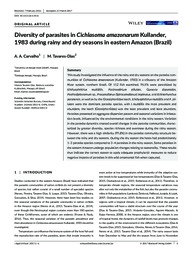Diversity of parasites in Cichlasoma amazonarum Kullander, 1983 during rainy and dry seasons in eastern Amazon (Brazil).
Diversity of parasites in Cichlasoma amazonarum Kullander, 1983 during rainy and dry seasons in eastern Amazon (Brazil).
Author(s): CARVALHO, A. A.; TAVARES-DIAS, M.
Summary: This study investigated the influence of the rainy and dry seasons on the parasite communities of Cichlasoma amazonarum (Kullander, 1983) in a tributary of the Amazon River system, northern Brazil. Of 112 fish examined, 95.5% were parasitized by Ichthyophthirius multifiliis, Piscinoodinium pillulare, Gussevia disparoides, Posthodiplostomum sp., Procamallanus (Spirocamallanus) inopinatus, and Echinorhynchus paranensis, as well as by the Glossiphoniidae leech. Ichthyophthirius multifiliis and P. pillulare were the dominant parasite species, with I. multifiliis the most prevalent and abundant; the leech (Glossiphoniidae) was the least prevalent and least abundant. Parasites presented an aggregate dispersion pattern and seasonal variations in infestation levels, influenced by the environmental conditions in the rainy season. Variation in the parasite dynamics created overall changes in the parasite communities, characterized by greater diversity, species richness and evenness during the rainy season.However, there was a high similarity (99.8%) in the parasite community structure between the rainy and dry seasons. During the dry season the hosts had predominantly 1?3 parasite species compared to 3?4 parasites in the rainy season. Some parasites in the eastern Amazon undergo population changes relating to seasonality. These results thus indicate the correct season to apply adequate prophylactic measures to reduce negative impacts of parasites in this wild ornamental fish when captured.
Publication year: 2017
Types of publication: Journal article
Unit: Embrapa Amapá
Observation
Some of Embrapa's publications are published as ePub files. To read them, use or download one of the following free software options to your computer or mobile device. Android: Google Play Books; IOS: iBooks; Windows and Linux: Calibre.
Access other publications
Access the Agricultural Research Database (BDPA) to consult Embrapa's full library collection and records.
Visit Embrapa Bookstore to purchase books and other publications sold by Embrapa.

